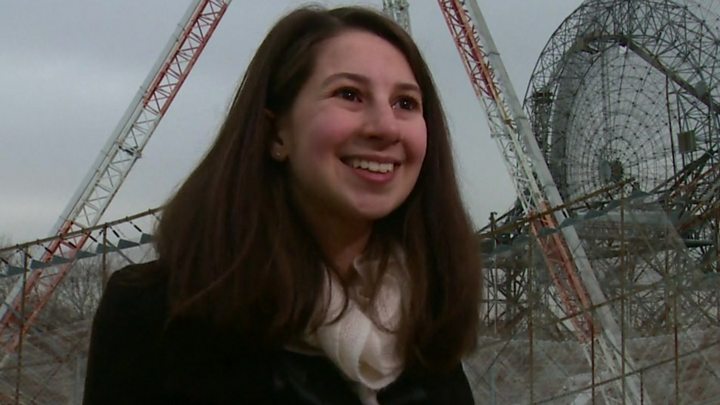
Media playback is unsupported on your device
A 29-year-old computer scientist has earned plaudits worldwide for helping develop the algorithm that created the first-ever image of a black hole.
Katie Bouman led development of a computer programme that made the breakthrough image possible.
The remarkable photo, showing a halo of dust and gas 500 million trillion km from Earth, was released on Wednesday.
For Dr Bouman, its creation was the realisation of an endeavour previously thought impossible.
Excitedly bracing herself for the groundbreaking moment, Dr Bouman was pictured loading the image on her laptop.
"Watching in disbelief as the first image I ever made of a black hole was in the process of being reconstructed," she wrote in the caption to the Facebook post.
She started making the algorithm three years ago while she was a graduate student at the Massachusetts Institute of Technology (MIT).
There, she led the project, assisted by a team from MIT's Computer Science and Artificial Intelligence Laboratory, the Harvard-Smithsonian Center for Astrophysics and the MIT Haystack Observatory.
The black hole image, captured by the Event Horizon Telescope (EHT) - a network of eight linked telescopes - was rendered by Dr Bouman's algorithm.
In the hours after the photo's momentous release, Dr Bouman became an international sensation, with her name trending on Twitter.
In a tweet, New York Democratic Rep Alexandria Ocasio-Cortez wrote that Ms Bouman should take her "rightful seat in history".
"Congratulations and thank you for your enormous contribution to the advancements of science and mankind," she tweeted. "Here's to #WomenInSTEM!," which stands for science, technology, engineering and mathematics.
Dr Bouman was also hailed by MIT and the Smithsonian on social media.
"3 years ago MIT grad student Katie Bouman led the creation of a new algorithm to produce the first-ever image of a black hole," MIT's Computer Science & Artificial Intelligence Lab wrote. "Today, that image was released."
But Dr Bouman, now an assistant professor of computing and mathematical sciences at the California Institute of Technology, insisted the team that helped her deserves equal credit.
The effort to capture the image, using telescopes in locations ranging from Antarctica to Chile, involved a team of more than 200 scientists.
"No one of us could've done it alone," she told CNN. "It came together because of lots of different people from many different backgrounds."
What do we know about the black hole?
- The black hole, which is "unseeable" to the naked eye, measures 40 billion km across, or three million times the size of the Earth
- It was scanned over a period of 10 days in the Messier 87 galaxy
- It is "larger than the size of our entire Solar System", Prof Heino Falcke, of Radboud University in the Netherlands, who proposed the experiment, told the BBC
How did her algorithm create the image?
Put simply, Dr Bouman and others developed a series of algorithms that converted telescopic data into the historic photo shared by the world's media.
In mathematics and computer science, an algorithm is a process or set of rules used to solve problems.
No single telescope is powerful enough to capture the black hole, so a network of eight was set up to so do using a technique called interferometry.
The data they captured was stored on hundreds of hard drives that were flown to central processing centres in Boston, US, and Bonn, Germany.
Dr Bouman's method of processing this raw data was said to be instrumental in the creation of the striking image.
She spearheaded a testing process whereby multiple algorithms with "different assumptions built into them" attempted to recover an photo from the data.
The results of the algorithms were then analysed by four separate teams to build confidence in the veracity of their findings.
"We're a melting pot of astronomers, physicists, mathematicians and engineers, and that's what it took to achieve something once thought impossible," Dr Bouman says.
https://www.bbc.com/news/science-environment-47891902Bagikan Berita Ini
















0 Response to "Katie Bouman: The woman behind the first black hole image - BBC News"
Post a Comment